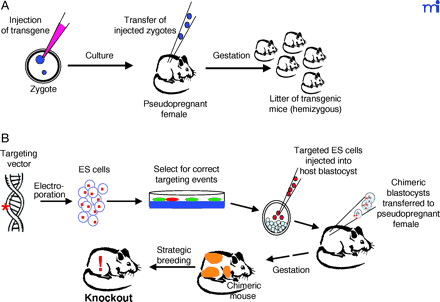
- Institution: Stanford Univ Med Ctr Lane Med Lib/Periodical Dept/Rm L109
- Sign In as Member / Individual
Transgenic Analysis of Human Drug–Metabolizing Enzymes: Preclinical Drug Development and Toxicology

Transgenesis and gene knockout. A. Transgenesis is schematized as a process in which “foreign” DNA is injected into the pronucleus of a fertilized egg, which is then transferred to a pseudopregnant female. The resulting pups may contain one or more copies of the injected transgene, at an untargeted site (or sites) within the genome. B . A gene “knockout” is the deletion of a specific gene (or a whole family of genes) from a functional genome, so that the effect of gene deletion can be correlated to changes in drug metabolism, toxic responses, or susceptibility to carcinogenesis. At the present time, the technology for performing gene knockouts using embryonic stem (ES) cells is routinely available only for the mouse; however, in the near future, it is likely that other species, such as the rat, will also be amenable to this technology. In addition, it is possible to exchange genes by homologous recombination; for example, by deleting a particular gene or transcription factor and simultaneously substituting it with the same gene from another species. The organism produced by such a substitution (i.e., containing a transgene in place of an endogenous gene) is referred to as a “knockin” animal.


